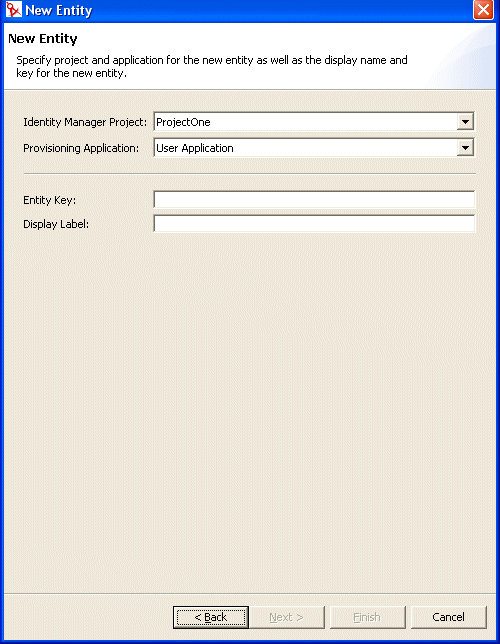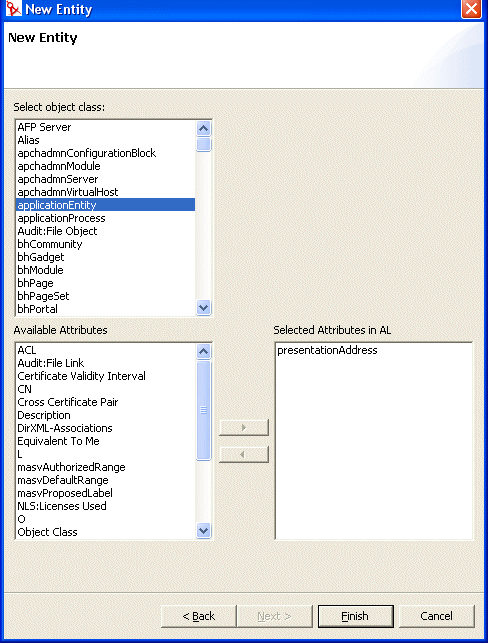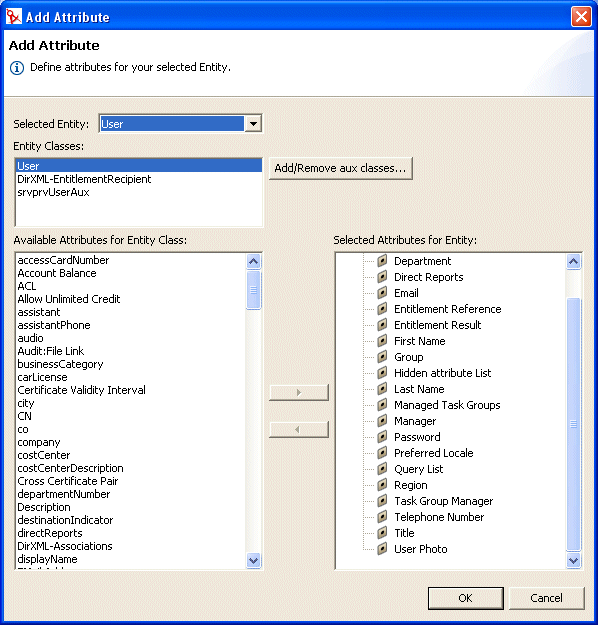3.2 Working with Entities and Attributes
You can customize your user application by adding objects and their attributes based on the content of your own Identity Vault. You do this by adding new entities and attributes to the directory abstraction layer and deploying them to the User Application driver.
To modify the entity files installed by default, see Section 3.2.1, Adding Entities and Section 3.2.2, Adding Attributes. To modify the entity files of an already deployed project or a set of files defined by another developer, you must first import the files to your design environment. For information on importing files, see Section 2.3, Importing Provisioning Objects.
3.2.1 Adding Entities
You add entities through the Add Entity Wizard (described next) or by clicking the button (from the editor’s toolbar).
NOTE:When using the button, you are prompted to select the object class of the entity to create, and the editor automatically adds the required attributes to the entity. Use the Add Attribute dialog box to complete the entity definition.
To add an entity using the Add Entity Wizard:
-
Launch the Add Entity Wizard in one of these ways:
From Designer’s menus:
-
Select . Choose , then click Next.
From the provisioning view:
-
Select the node, right-click, then choose .
From the directory abstraction layer editor:
-
Select , or
-
Select the node, right-click, then choose .
The New Entity dialog box displays.
NOTE:If launched from the menu, the dialog box contains the additional fields shown below.

-
-
Fill in the fields as follows:
Field
Description
The Identity Manager project and the provisioning application where you want to add the entity and attributes.
NOTE:These fields display when you launch the wizard from the menu.
A unique identifier for the entity.
The string displayed when the entity is displayed by the user application. You can localize this label. For more information, see Section 3.6, Localizing Display Text.
-
Click . The New Entity dialog box displays:

-
Choose the entity’s object class and add the attributes you want by double-clicking them in the list.
HINT:If the entity’s object class is not shown in the list, you should update Designer’s local schema file following the steps described in Updating the Schema Elements List.
-
Click .
The property page displays for editing. For more information, see Entity Properties. You must deploy the entity before it is available to the user application.
3.2.2 Adding Attributes
-
Select an entity.
-
Add an attribute by:
-
Right-click then select
or
-
Clicking the button.
or
-
Select .
You are prompted to choose classes and attributes.

-
-
Add attributes by double-clicking them in the list.
HINT:If the attribute you want to add is not displayed in the Available Attributes from Entity Class list, you should update Designer’s local schema file by following the procedure in Updating the Schema Elements List. LDAP operational attributes are not supported by the directory abstraction layer editor or user application.
-
Click . The property page displays for editing. For more information, see Attribute Properties. To make an attribute available to the user application, you must deploy it.
3.2.3 Updating the Schema Elements List
-
With the Identity Manager project open, select your Identity Vault, right-click and select
-
Choose and provide the specifications for the eDirectory host.
-
Click .
-
Select the classes and attributes to import, then click
NOTE:LDAP operational attributes are not supported by the directory abstraction layer editor or user application so you will not see them in any attribute lists after importing schema.